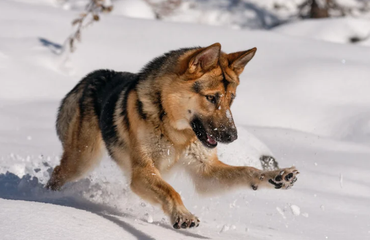
Interesting facts about Siberian Husky
The Siberian Husky, bred by the Chukchi for sled-pulling, is energetic, intelligent, and friendly. Known for endurance, they have a thick coat and striking eyes.
- Physically:
- Muscular, Flexible, Distinctive.
- Intelligence:
- Quick-witted, Easily trainable, Work-minded.
- Loyalty:
- Faithful, Defender, Devoted.
- Activity:
- Energetic, Playful, Robust.
- Lifespan:
- 9-13 years
- Weight:
- (Male): 30-40 kg, (Female): 22-32 kg

History
The Siberian Husky has a rich and fascinating history that traces back to the Chukchi people of northeastern Asia. This ancient breed was developed thousands of years ago to meet the specific needs of these nomadic Siberian tribes.
Origins:
The Chukchi people relied heavily on their dogs for survival in the harsh Arctic environment. They bred the Siberian Husky to be an efficient sled dog capable of hauling light loads over long distances at moderate speeds. These dogs needed to be resilient, hardworking, and capable of thriving in freezing temperatures. The Chukchi valued these traits, as well as the dogs' ability to form strong bonds with humans, which was essential for working in close quarters and providing companionship.
Characteristics of Early Huskies:
Early Siberian Huskies were smaller, faster, and more enduring than the larger, heavier sled dogs used in other regions. Their thick double coats provided insulation against the cold, while their friendly and gentle nature made them suitable for living closely with families.
Introduction to North America:
The Siberian Husky was introduced to North America in the early 20th century. The breed gained international attention during the early 1900s, when they were brought to Alaska for sled dog racing. In 1909, a team of Siberian Huskies participated in the All-Alaska Sweepstakes, a 408-mile dogsled race. Despite being smaller than the native Alaskan Malamutes, the Huskies impressed spectators with their speed and endurance.
The Serum Run of 1925:
The Siberian Husky's place in history was solidified during the 1925 serum run to Nome, Alaska. An outbreak of diphtheria threatened the town, and the only way to deliver life-saving antitoxin was by sled dog relay across 674 miles of treacherous terrain. Led by famous mushers like Leonhard Seppala and his lead dog Togo, as well as Gunnar Kaasen with his lead dog Balto, the Siberian Huskies played a crucial role in successfully delivering the serum. This heroic effort not only saved countless lives but also brought widespread recognition to the breed's capabilities.
Post-Serum Run Popularity:
Following the serum run, the Siberian Husky's popularity soared. They became a favorite in sled dog racing and were officially recognized by the American Kennel Club (AKC) in 1930. The breed's charming appearance and friendly nature also made them popular as family pets.
Modern Day:
Today, the Siberian Husky continues to excel in sled dog racing and other canine sports. They are beloved for their friendly, outgoing personalities and striking looks. Huskies have also made their mark in popular culture, appearing in movies, books, and as mascots for various organizations.
Breed Preservation and Adaptation:
While the Siberian Husky has adapted to various roles beyond sledding, efforts to preserve the breed's working capabilities and historical traits remain strong. Breeders and enthusiasts strive to maintain the physical and mental characteristics that made the Siberian Husky such an integral part of the Chukchi culture and a hero in the 1925 serum run.
Рагледай ощеFacts
On average, dogs can learn over 1,000 words and commands, demonstrating their intelligence and ability to understand human language.
Dogs have an incredibly keen sense of smell, with some breeds being able to detect odors up to 100,000 times better than humans.
The Saluki dog breed is one of the oldest known dog breeds, dating back to ancient Egypt over 5,000 years ago.
Dogs have been domesticated for over 15,000 years, making them some of the oldest domesticated animals.
The Basenji dog breed is known as the "barkless dog" because it doesn't bark like other dogs. Instead, it makes a unique sound similar to yodeling.
The smallest dog breed in the world is the Chihuahua, named after the state of Chihuahua in Mexico.
TODAY WITH THE DOGS
We present to you the most interesting facts about breeds in our curated collection. Discover the world of dogs today!



Suggest a breed for the next post.
Send us your suggestion for a breed you'd like to see in the next post. Your input is important to us!